Oakport
Houses within 10km of this house
Displaying 58 houses.
Houses within 10km of Oakport
Displaying 58 houses.
| House name | Description | |
|---|---|---|
| Rockingham | Sir Robert King, Viscount Lorton, built Rockingham House around 1810 and the family moved there from King House in Boyle. At the time of Griffith's Valuation Rockingham was valued at £180. In 1903 Rockingham became the county residence of the Lord Lieutenant Lord Dudley. It was destroyed by fire in 1957 and subsequently demolished. Only some of the servants' tunnels as well as other estate buildings remain. The site is now occupied by Lough Key Forest Park. |

|
| Alderford | At the time of Griffith's Valuation Alderford was leased by the representatives of William F. McDermottroe to Catherine Thompson and was valued at £25. In 1814 it was the seat of Thomas McDermottroe. Lewis also records it as the seat of the latter in 1837. Alderford is famous for its associations with Turlough O'Carolan, the Irish harper, as he died there in 1738 and is buried nearby in Kilronan. This house, however, was built in the early 19th century. It was the seat of Thomas Charles McDermottroe in 1894. It is still extant but in a dilapidated condition. |

|
| Kilronan Castle/Castle Tennison | The house presently occupying this site was constructed in the later 19th replacing an earlier house which had been built c.1820. At the time of Griffith's Valuation the house had been valued at £70 and was occupied by Edward King Tenison. In 1814 it was the seat of Thomas Tennison and is recorded by Lewis as the seat of Col. Tenison. In 1894 Slater referred to it as a residence of the Earl of Kingston. The building is still extant and in 2006-7 was converted into a luxury hotel. For more information on Kilronan Castle see www.kilronancastle.ie. |
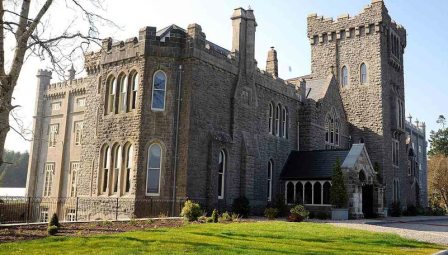
|
| Hatley Manor | This house was built c. 1830. At the time of Griffith's Valuation Charles St. George was leasing it to Diana Faris. It was later inherited by the Whyte family of Newtown Manor and is recorded by Slater as the seat of Charles C. Beresford Whyte in 1894. It is still extant and had been in use by the Bank of America. In April 2007 it was offered for sale. |

|
| Castlecarra (Leitrim) | This house was occupied by the Peyton family later in the 19th century. In 1814 it was the address of Mr. A. O'Beirne. In 1906, when it was the property of Mrs. William Peyton it was valued at £10. | |
| Port | Port is given as the address of Guy Cooper in 1814 while in 1856 the house at Port was occupied by George Latimer. | |
| Drumhierny Lodge | At the time of Griffith's Valuation William LaTouche was leasing this property, valued at £15, to Francis LaTouche. Originally built by David La Touche and lived in by successive generations of the family until the early years of the twentieth century. Sold in 1912 and now a ruin. | |
| Shannon Lodge | Alexander or Alick Faris leased property from the St. George estate in Carrick-on-Shannon. His wife Diana is recorded as the occupier of the house known as Shannon Lodge at the time of Griffith's Valuaiton, when it was valued at £30. Pyle states that after Alick Faris died Diana married a French aide of the St.George's, Victor de l'Herrault. She resided at Shannon Lodge for some time but after her second husband died she moved to Sligo and rented Shannon Lodge to her brother, James. She died in 1890. |
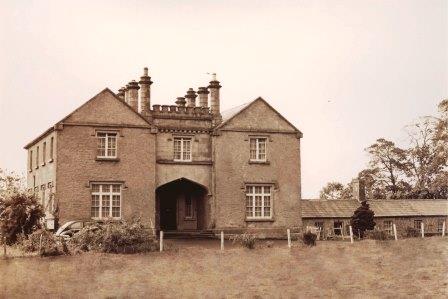
|
| Estersnow Glebe | At the time of Griffith's Valuation the Ecclesiastical Commissioners were leasing a house at Cavetown valued at £10 to Rev. Frederick Hamilton. It is described as "a good glebe house, the residence of the incumbrant of Estersnow" at the time of the 1st Ordnance Survey. It is still extant and occupied. | |
| Ardcarne House | At the time of Griffith's Valuation John Hackett was leasing Ardcarne House, valued at £25, from Viscount Lorton's estate. The house is still extant and used as a farmhouse. |

|
| Glencarne House | At the time of Griffith's Valuation Samuel Handy was leasing a house valued at £18 at Ardcarne, barony of Boyle, from Viscount Lorton's estate. Glencarne is now a guesthouse. |

|
| Castle Island | Also known locally as the Rock of Lough Key, at the time of Griffith's Valuation Viscount Lorton's estate owned a house on Castle Island valued at £14. The original building on the island was a medieval stronghold of the McDermott family to which additions were made in the early 19th century. Renovation work was taking place on these buildings in 2007. |

|
| Ardcarn Glebe | At the time of Griffith's Valuation Viscount Lorton was leasing the Glebe House in Ardcarn parish to Rev. George Griffith when it was valued at £12. It is still extant and is part of a large farming enterprise. |

|
| Grevisk | At the time of Griffith's Valuation Thomas Phibbs Peyton was leasing a house at Grevisk, valued at £10, along with 100 acres, from Viscount Lorton's estate. The Census of 1749 recorded Grevisk as the home of John Nesbit. It is still extant. | |
| Knockvicar | At the time of Griffith's Valuation Charles J. Peyton was leasing a house at Knockvicar, parish of Ardcarn, valued at £15 to Edward Jones. Lewis records the house as the seat of C.J. Peyton in 1837. In 1814 it was the seat of Randal Peyton. | |
| Drumdoe | At the time of Griffith's Valuation, John Wolfe Flanagan was leasing a house at Drumdoe from Viscount Lorton's estate, valued at £28. This house is described as "a good house, formerly the residence of Colonel Lilly" at the time of the first Ordnance Survey. A larger house was constructed some time after this and appears on the 25-inch map of the 1890s. This latter house is still extant. | |
| Mount Erris | At the time of Griffith's Valuation William Duckworth was leasing this house valued at £26 from Viscount Lorton's estate. There is still an inhabited house at this site. |

|
| Tangier | Caleb Robertson is recorded as occupying the house known at the time of the first Ordnance Survey. He is noted as the immediate lessor at the time of Griffith's Valuation though the house was unocciped and valued at £28. Tangier House was occupied by Harward O'Farrell, a doctor, in the second half of the 19th century. His third son, Sir George Plunkett O'Farrell, was granted arms in 1909. A house is still extant at the site. | |
| The Warren | Caleb Robertson is recorded as the lessor of a property in the townland of Warren or Drum at the time of Griffith's Valuation. It was valued at £25 and leased to a Captain Butler. A house at this site is labelled The Warren on the 25-inch map of the 1890s and a house still exists there. | |
| Millmount | Viscount Lorton was leasing a house valued at £18 at Macmoyne, parish of Boyle, to Nicholas Mulhall, at the time of Griffith's Valuation. This may be the still extant Millmount House, associated with the milling complex. |

|
| Moylurg House | In 1837 Lewis records Moylurg house as the seat of the Dick family. Rev. William Robertson was leasing a property valued at £25 to John Johnston, at Clogher, parish of Eastersnow, at the time of Griffith's Valuation. This appears to be Moylurg House which is still extant. Moylurg was the home of Major Henry Taaffe Ferrall in the 1870s. |

|
| Cavelawn | Guy Lloyd was leasing a house at Faus valued at £10 to James Acheson at the time of Griffith's Valuation. The house at this site is labelled Cavelawn on the 25-inch Ordnance Survey map of the 1890s. A house is still extant at the site. | |
| Havarine Cottage | Anna Maria Fry was leasing a house valued at £11 from Lord Lorton's estate at Tullyvohaun, barony of Boyle, at the time of Griffith's Valuation. At the time of the first Ordnance Survey Havarine Cottage, at Tullyvohaun, was described as a ''gentleman's seat', the residence of Mrs. Fry. | |
| Frybrook House | Frybrook House was built by Henry Fry, who came to Boyle in 1742, and established a weaving industry in the town. It is still extant. In 2025 it was offered for sale. |

|
| King House | King House was built between 1720-1740 by Sir Henry King. In 1786 Wilson wrote "the Earl of Kingston has a very fine house at Boyle, situated near the ruoins of an ancient abbey". Following a fire in 1788 the King family vacated the house and moved to Rockingham on the shores of Lough Key. King House was used as a military barracks until the 1960s. It is now in the ownership of Roscommon County Council and is open to the public. |

|
| Lough Key House | At the time of Griffith's Valuation, Alicia Peyton was leasing a house valued at £13 at Ballykeevican, barony of Boyle, from Viscount Lorton's estate. This property is now Lough Key House guesthouse. |

|
| Carrickard House | At the time of Griffith's Valuation, Charles Peyton was leasing a house at Keeloges, valued at £25, from Lord Lorton's estate. |

|
| Riversdale House | John R. French was leasing a house valued at £25 at Kilateasheen from the Ecclesiastical Commissioners at the time of Griffith's Valuation. There is no substantial house marked on the 1st edition OS map. This house is still extant and known as Riversdale House. |
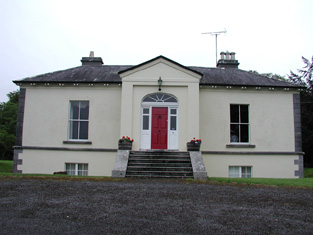
|
| Croghan | At the time of Griffith's Valuation, Guy Lloyd was the occupier of the house at Croghan, valued at £40. In 1749 the Census of Elphin shows that J. Lloyd, spinster, lived there. Wilson also notes it as a seat of the Lloyd family in 1786. Croghan House is no longer extant but an extensive range of outbuildings remains. |

|
| Killukin Glebe/Killukin House | At the time of Griffith's Valuation, Archdeacon Henry Irwin was occupying the Glebe House in the parish of Killukin, valued at £11. This property is labelled Killukin House on the 25-inch Ordnance survey map of the 1890s. A house is still extant at the site. | |
| Cloverhill | At the time of Griffith's Valuation, Thomas Cox was leasing a house from the Lloyd estate at Bunreagh, barony of Boyle, valued at £10 . This property is labelled Cloverhill on the 25-inch map of the 1890s. A house and substantial farn are still extant at the site. | |
| Danesfort (Roscommon) | At the time of Griffith's Valuation, William Roycroft was leasing the house at Danesfort, valued at £12, from Miss M. O'Connor. In 1814 it was recorded as the seat of Gilbert Roycroft. Lewis also describes "Deansfort" as the seat of the Roycroft family in 1837. Keenehan and others state that the Roycroft house was demolished c.1890 and another house constructed on the site by the Duignan family. | |
| Hermitage | Lewis records the Lloyd family occupying a second house called Hermitage also located in the townland of Croghan. Buildings still exist at the site. | |
| Knockranny | At the time of Griffith's Valuation Knockranny House was leased by Joseph Bennett Little from the Tenison estate and was valued at £25. Lewis recorded the house as the seat of the Dodwell family. Knockranny is still extant but derelict. |

|
| Greyfield | At the time of Griffith's Valuation, Greyfield, barony of Boyle, was leased by Robert O'Donnell from the O'Reilly estate. It was valued at £10. Lewis also records Greyfield as the seat of the O'Donnell family in 1837. The original house is no longer extant. | |
| Cloongownagh | Thomas and Andrew Kirkwood had houses in this locality in 1814. Thomas resided at Hermitage and Andrew at Lakeview. At the time of Griffith's Valuation Andrew Kirkwood was occupying a property at Cloongownagh, barony of Boyle, valued at £13. Keenehan and others state that Cloongownagh House was built in 1690. It was occupied by the Kirkwood family until 1939 when Col. Moore Kirkwood sold the house and 109 acres. The house is still extant and occupied and is now part of a farm. | |
| Woodbrook House | Keenehan and others state that Woodbrook House was built around 1780 by the Phibbs family although there may have been an earlier house on the site. The Kirkwood family purchased the property sometime in the early nineteenth century. At the time of Griffith's Valuation Sarah Mary Kirkwood was leasing a house at Usna, barony of Boyle, valued at £14, from Robert H. Brewster French. From the 1890s-1911 Woodbrook was a very successful racing stables run by Colonel Tom Kirkwood. Life in the house in the post-WWI era has been made famous by the memoir ''Woodbrook'' written by the Scottish author David Thomson, a tutor to the daughters of the family. In 1946 over 50 acres of the estate was sold to the local golf club while the Land Commission subsequently divided the remainder. Woodbrook House is still extant. | |
| Springfield House | At the time of Griffith's Valuation, John Keogh was leasing a house at Cultycuneen, barony of Boyle, valued at £13, to Joseph Backhouse. Keenahan and others state that this house was built by the Backhouse family in the 1790s. It remained in the family until the mid twentieth century. It is still extant and has been recently refurbished. | |
| Carrowreagh | Richard O'Farrell Caddell was leasing a "herd's" house valued at £8, together with over 350 acres, at Carrowreagh, barony of Boyle, to Thomas Boylan, at the time of Griffith's Valuation. A house and farm are still extant at the site. Patrick Fox was leasing a mill property from the Caddell estate in the same townland. Some stone buildings remain at the site though the mill was described as "in ruins" on the 25-inch Ordnance Survey map of the 1890s. | |
| Finnor House | At the time of Griffith's Valuation, Richard O'Farrell Caddell was leasing a house valued at £8, at Finnor, barony of Boyle, to Michael Barrett. It s labelled "Finnor House" on the 25-inch Ordnance Survey map of the 1890s and a house still exists at the site. | |
| Hughestown | The seat of the Mulloy family is described as Hughestown but at the time of Griffith's Valuation the buildings at this location are described as "offices" and have a low valuation. C.M. Mulloy was resident at "Husetown"in 1749. Wilson refers to Hughes-town as the seat of Mr. Molloy in 1786. In 1814 Hughestown was the seat of Mulloy McDermott. | |
| Ellesmere | Harloe Powell was leasing a house valued at £18 at Ardcarn, barony of Boyle, from Viscount Lorton's estate, at the time of Griffith's Valuation. This house is still extant and occupied. |

|
| Lyonstown | At the time of the first Ordnance Survey a large ruin, said to have been the residence of the Lyons family, was in the possession of the O'Donnell of Greyfield estate. | |
| Abbey View House | Morgan Crofton, agent to Lord Lorton, was residing here at the time of the first Ordnance Survey. At the time of Griffith's Valuation it was occupied by Caleb Robertson and valued at £34. A house is still extant at Abbey View. |

|
| Coote Hall | In the seventeenth and eighteenth centuries Coote Hall was owned by the Coote family. The 4th and 5th Baronets, both named Charles, lived there and it was one of the houses O'Carolan visited and for whom he composed tunes. It was bought by Maurice O'Conor in the 18th century and later again by the Barton family. There is still an extant house at the site. |
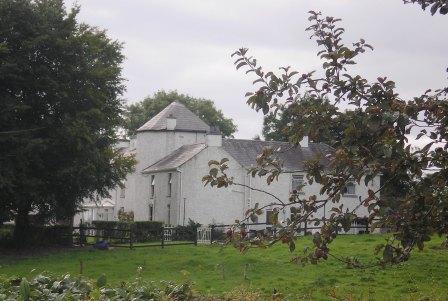
|
| Holywell | Holywell was built in the 1790s. In the early nineteenth century it was leased from the St. George estate by the Dockery family who in turn leased it to the Munns family, doctors in Carrick-on-Shannon. It was later the home of the Kiernan family and is now a country guesthouse. |

|
| Cavetown | In 1786 Wilson notes Cavetown as the seat of the Rev. Dean Mahon and the Reverend Arthur Mahon resided there in 1814. At the time of the first Ordnance Survey a ''gentleman's seat of two stories'' is noted in Cavetown. Guy Lloyd is recorded as the proprietor. This may be the property, valued at £5, leased from the Lloyd estate by Geo. Laird at the time of Griffith's Valuation. There are buildings still extant at this site. |

|
| Rushfield | At the time of the first Ordnance Survey Mr. A. Irwin is noted as the occupier of one of two ''gentlemen's seats' at Tullyvohaun, barony of Boyle. In 1814 it was the residence of John Irwin. This property was valued at £8 and was occupied by William Phibbs at the time of Griffith's Valuation. A substantial farm still exists at the site. | |
| Caldragh | Eliza Lawder was leasing a house valued at £7 10s at Caldragh, parish of Kiltoghert, from George Muntz at the time of Griffith's Valuation. In 1837 Lewis recorded it as the seat of the McDermott family. This house is still extant and run as a guesthouse by the Jackson family. |
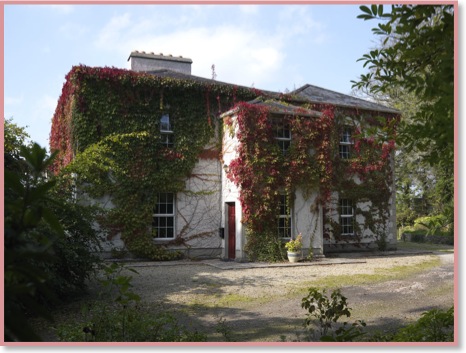
|
| Cartown | In 1783 Taylor and Skinner recorded Cartown, close to the town of Carrick-on-Shannon, as a seat of the Cunningham family and Wilson, writing in 1786, also refers to it as the seat of Mr. Cunningham. At the time of Griffith's Valuation George Church was in possession of a property in this townland, valued at £12, described as "unfinished". The house shown on the 25-inch Ordnance Survey map of the 1890s is substantially larger than the 18th century house. The house now at this site has had commercial premises attached to it but is still extant. |
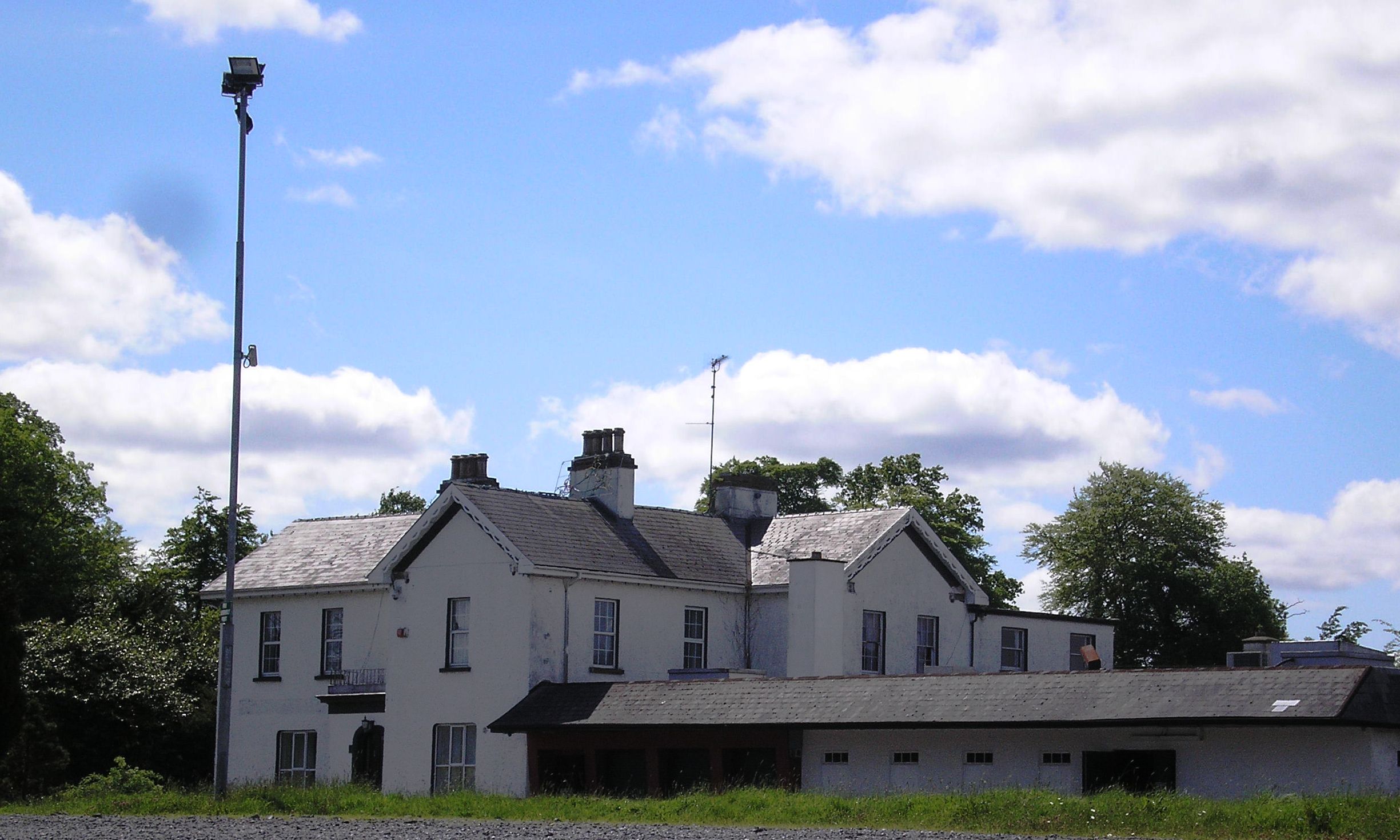
|
| Hartley | At the time of Griffith's Valuations Charles St. George was leasing a house valued at £10 at Hartley, barony of Leitrim, to Robert Burns. It is unclear if this house has survived due to dense forestry and building of modern mansions. | |
| Holly Park (Leitrim) | In 1786 Wilson refers to a house close to Leitrim village as the seat of William Houghton. He may be referring to the house named on the 1st edition Ordnance Survey map as Holly Park. At the time of Griffith's Valuation Francis La Touche was leasing this property, valued at £4, at Tullylannan, to Edgar Macklin. Extensive redevelopment has taken place in this area | |
| Carrickard | At the time of Griffith's Valuation, Rev. Arthur Hyde was leasing a house at Carrickard, barony of Tirerrill from the estate of Robert Gough. The house was valued at £8. | |
| Drum Lodge | One of the many surviving gatelodges on the Rockingham Demesne. |

|
| Andresna | Meredith Thompson was leasing a property valued at £6 at Andresna, barony of Tirerrill, to William Thompson at the time of Griffith's Valuation. | |
| Castlefield House | At the time of Griffith's Valuation Meredith Thompson, senior, was occupying a house valued at over £5 at Anresna, barony of Tirerrill. This appears to be the house marked on the OS map as Castlefield House, on the shores of Lough Arrow. McTernan notes that it later came into the possession of the Acheson family who sold it in 1935. It is still extant but in 2009 was unoccupied. | |
| Gallowshill | A house built for the St George family at the end of the eighteenth century but used as a hospital for the Carrick-on-Shannon area until the 1940s. |

|
| Cloontykilla Castle | This building was constructed after the publication of the first Ordnance Survey Map. It appears to have functioned as a shooting/fishing lodge for the King estate. It is now a ruin. |
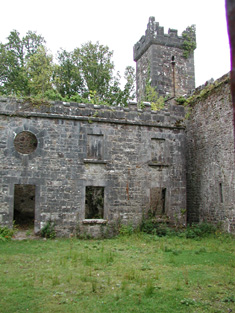
|

